After leaving the famous city of Florence, colored by its buzzing streets and magnificent architecture, we headed south to explore the rich lands of the Tuscan countryside. The first stop of our journey was a town called San Gimignano. The drive to the town was almost as glorious as the town itself, endless miles of scenic rolling hills, enriched with vineyards and groves of olive trees.
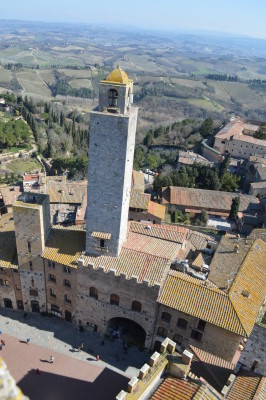 The town is set on a hill with narrow streets, cobblestone roads, and high defensive walls. The most noticeable characteristic about the town are its famous towers which date back to a period when prosperous families sought prestige by building towers to match the height of their status. Currently 14 of the 72 original towers still remain. We were lucky enough to climb the Torre Grossa to catch an exquisite view of the piazza and the rolling hills of Tuscany. Despite the fierce winds at the top of the tower, the essence of beauty and culture this little town exuded is one I will always remember.
The town is set on a hill with narrow streets, cobblestone roads, and high defensive walls. The most noticeable characteristic about the town are its famous towers which date back to a period when prosperous families sought prestige by building towers to match the height of their status. Currently 14 of the 72 original towers still remain. We were lucky enough to climb the Torre Grossa to catch an exquisite view of the piazza and the rolling hills of Tuscany. Despite the fierce winds at the top of the tower, the essence of beauty and culture this little town exuded is one I will always remember.
Continuing on the cultural leg of the journey our travels took us to the Tuscan city of Siena. Nothing is better than eating gelato and roaming the streets of Siena. This little medieval town has insanely steep cobblestone streets that will give your glutes a run for their money. 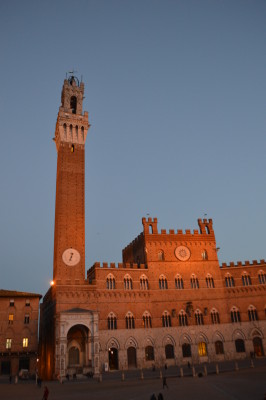
The central piazza, known as Il Campo, (at right), is shaped like a seashell, which is different than any other piazzas we’ve seen. We learned that a horse-race occurs twice a year in July and August around the piazza, and each of the 18 districts of Siena has it’s own horse and flag.
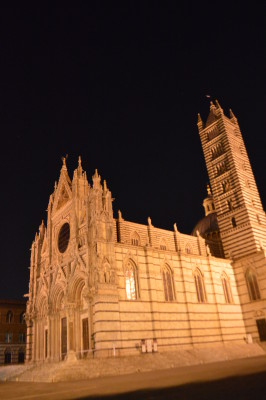
The Duomo of Siena (at left), is nothing shy of spectacular.
One of my favorite pictures taken on this trip was the cathedral with its zebra like black and white stripes and large pane circular window that let the sunlight flow through. We left Siena right at sunset, as we strolled through the streets, the ambience of the muted voices and dim street-lights was warm and soothing.
For a moment there, I lost myself in the breathtaking beauty of Siena and stopped in time in the 13th century. Check back for the next blog post as we pick up our CHS Inc. agricultural tour of Italy with a tour of a Tuscan winery run by one family for 13 generations.


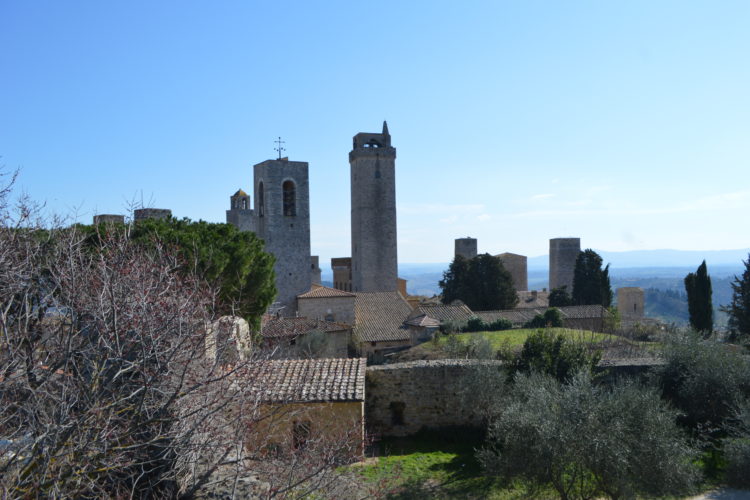
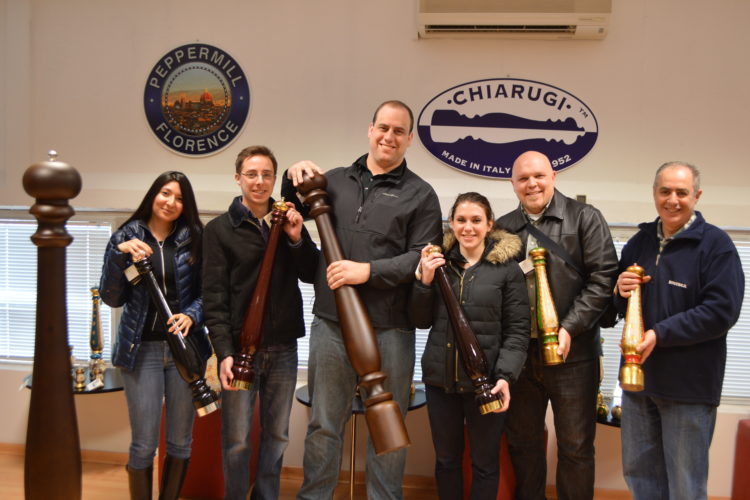
 The first company, IVV, is the largest glass manufacturer in Europe. They make the majority of their products completely by hand, and the results were quite impressive. The company makes large vases, colorful flowers, and nearly any tabletop object imaginable. The factory itself was also a sight to be seen; Professor Sergio Chayet would have refused to leave if he had been here.
The first company, IVV, is the largest glass manufacturer in Europe. They make the majority of their products completely by hand, and the results were quite impressive. The company makes large vases, colorful flowers, and nearly any tabletop object imaginable. The factory itself was also a sight to be seen; Professor Sergio Chayet would have refused to leave if he had been here. Our final visit was to Capecchi Home Linens, located in Pistoia. The company has been in the same family for three generations and we had the opportunity to tour the facility with its current owner. The company imports high quality cotton from Egypt and the Middle East, and then dyes, embroiders, and finishes the sheets, pillow cases, and other linen goods in house.
Our final visit was to Capecchi Home Linens, located in Pistoia. The company has been in the same family for three generations and we had the opportunity to tour the facility with its current owner. The company imports high quality cotton from Egypt and the Middle East, and then dyes, embroiders, and finishes the sheets, pillow cases, and other linen goods in house. The company produces only when orders come in, and they offer their customers the ability to customize the products to a large degree. Speaking with the owner after the tour, he indicated that he does not want to become a high volume producer like some manufacturers in China. In fact, his goal was simply to add one new customer per year, so long as this customer builds a relationship with him.
The company produces only when orders come in, and they offer their customers the ability to customize the products to a large degree. Speaking with the owner after the tour, he indicated that he does not want to become a high volume producer like some manufacturers in China. In fact, his goal was simply to add one new customer per year, so long as this customer builds a relationship with him.
 We were first shown The Villa di Maiano, the impressive main house on the estate, which still had the original décor and furnishings and was the set for the films Tea with Mussolini and A Room with a View. We toured through the house, the exterior garden and terrace. Awed by the views, we saw the working olive farm situated on nearly 300 hectares of land encompassing nearly 20,000 olive trees.
We were first shown The Villa di Maiano, the impressive main house on the estate, which still had the original décor and furnishings and was the set for the films Tea with Mussolini and A Room with a View. We toured through the house, the exterior garden and terrace. Awed by the views, we saw the working olive farm situated on nearly 300 hectares of land encompassing nearly 20,000 olive trees. From the villa, Tomas graciously gave us a tour of the estate mill and described the olive oil production process. I was impressed when he said that the olives are picked entirely by hand and that the estate is completely organic. The olives are typically picked in November and December, and they are processed in the olive mill via a cold extraction process within 6.5 hours of being picked.
From the villa, Tomas graciously gave us a tour of the estate mill and described the olive oil production process. I was impressed when he said that the olives are picked entirely by hand and that the estate is completely organic. The olives are typically picked in November and December, and they are processed in the olive mill via a cold extraction process within 6.5 hours of being picked.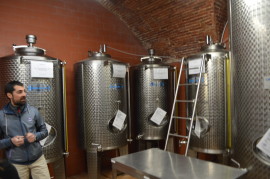 When I first learned of the trip, and the support it had received from the CHS Foundation to gain exposure to the agriculture industry, I was excited at the opportunity to learn more about the food products I use in my everyday life. Fattoria de Maiano did not disappoint. It was incredible to see the entire process and to learn exactly how extra virgin olive oil is characterized and the difference from regular virgin olive oil – extra virgin olive oil comes from the first pressing of the olives, contains no more than 0.8% acidity, and is judged to have superior taste.
When I first learned of the trip, and the support it had received from the CHS Foundation to gain exposure to the agriculture industry, I was excited at the opportunity to learn more about the food products I use in my everyday life. Fattoria de Maiano did not disappoint. It was incredible to see the entire process and to learn exactly how extra virgin olive oil is characterized and the difference from regular virgin olive oil – extra virgin olive oil comes from the first pressing of the olives, contains no more than 0.8% acidity, and is judged to have superior taste.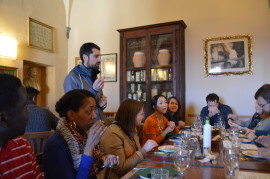
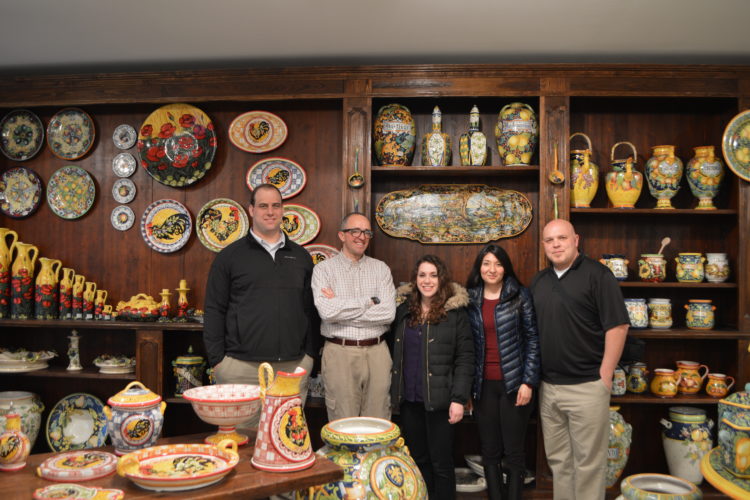
 The first workshop we visited was Ceramiche D’Arte Ammannati, namesake of the famed and controversial marble worker who sculpted the Fountain of Neptune in the Piazza Vecchio.
The first workshop we visited was Ceramiche D’Arte Ammannati, namesake of the famed and controversial marble worker who sculpted the Fountain of Neptune in the Piazza Vecchio.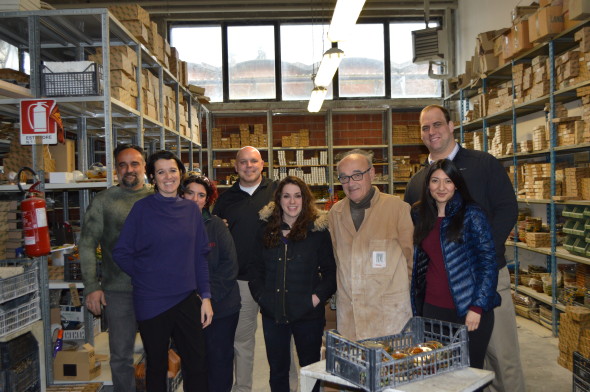 Next, we toured perhaps the most unique and modern facility on our trip, Marzi srl. Using resin and natural materials, Marzi blends together the modern ephemeral trends of society with the interminable style of nature. Martzi capitalizes on the juxtaposition of modern tastes with ancient roots, and creates products as at home in a 21st century resort hotel as a 15th century Tuscan farmhouse.
Next, we toured perhaps the most unique and modern facility on our trip, Marzi srl. Using resin and natural materials, Marzi blends together the modern ephemeral trends of society with the interminable style of nature. Martzi capitalizes on the juxtaposition of modern tastes with ancient roots, and creates products as at home in a 21st century resort hotel as a 15th century Tuscan farmhouse.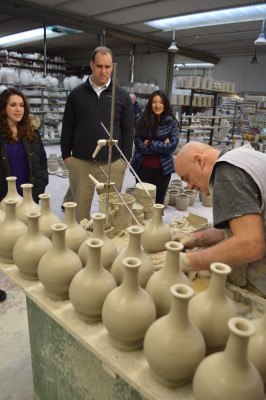 The third visit of the day was to a larger company called Ceramiche IMA. While Ammannati has very flexible production capabilities, it cannot produce the large volumes of ceramic pieces required from larger stores in the United States. IMA, however, has the facilities and capability to meet demand for companies like Pottery Barn in the United States, who need larger orders of identical objects.
The third visit of the day was to a larger company called Ceramiche IMA. While Ammannati has very flexible production capabilities, it cannot produce the large volumes of ceramic pieces required from larger stores in the United States. IMA, however, has the facilities and capability to meet demand for companies like Pottery Barn in the United States, who need larger orders of identical objects.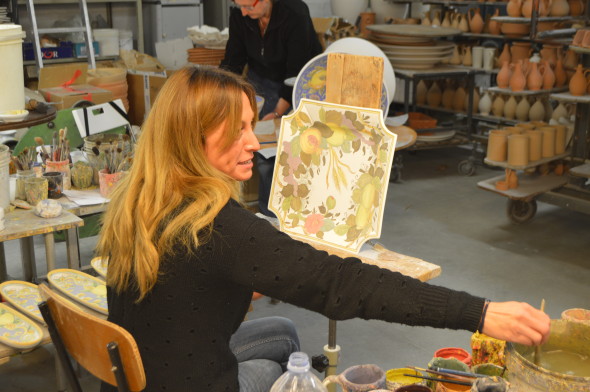 Our last stop of the day was a Ceramiche MORI, a five person operation nestled into a larger industrial area.
Our last stop of the day was a Ceramiche MORI, a five person operation nestled into a larger industrial area.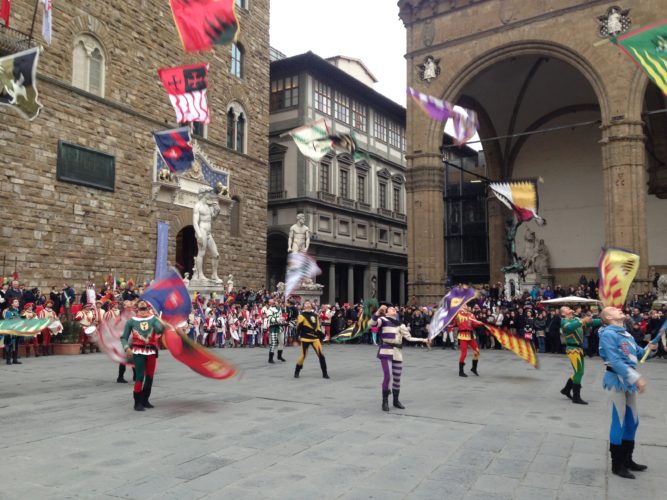
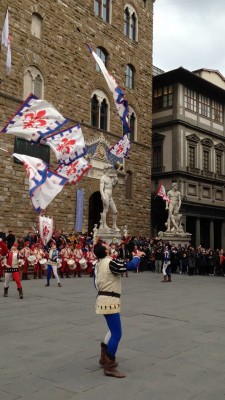


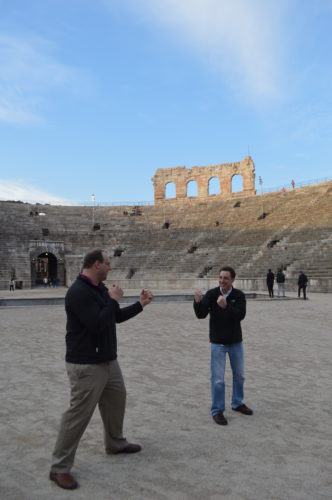
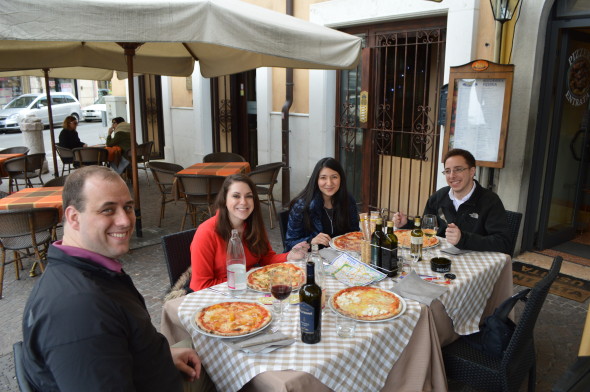 After sitting down for a delicious meal of pizza, washed down with some Chianti, and gelato, we then wandered about the town square and into the Duomo. Verona had a strong fortress that was built around it during the medieval times to protect it from enemies.
After sitting down for a delicious meal of pizza, washed down with some Chianti, and gelato, we then wandered about the town square and into the Duomo. Verona had a strong fortress that was built around it during the medieval times to protect it from enemies. 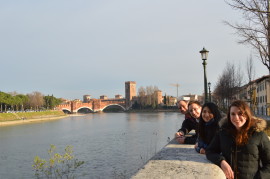 We stood on top of the crenulated bridge that connected the two sides of the town, and looked down upon the river.
We stood on top of the crenulated bridge that connected the two sides of the town, and looked down upon the river. We walked across the town to see the old Roman ruins and stood upon the steps in the Verona Arena. It was both eerie and awe inspiring to see the giant marble slab steps and realize how many centuries had passed since they were built. Remnants of the old Roman aqueduct surrounded the Arena, and it was fascinating to realize and see in person how advanced the Roman technology was during the ancient times.
We walked across the town to see the old Roman ruins and stood upon the steps in the Verona Arena. It was both eerie and awe inspiring to see the giant marble slab steps and realize how many centuries had passed since they were built. Remnants of the old Roman aqueduct surrounded the Arena, and it was fascinating to realize and see in person how advanced the Roman technology was during the ancient times.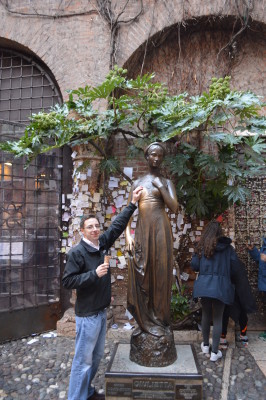 After the Arena, we wound or way through the cobbled streets to Juliet’s balcony. The nondescript, white balcony was tucked away in an alcove off of the main path. Rumor has it that Shakespeare never actually visited Verona in his life; but the romantic in each of us believes that by visiting the balcony and rubbing the breast of the statue of star-crossed Juliette, we will bring fortune to our own romantic endeavors. After taking a long walk back along the brightly lit river, we headed off to catch some blessed sleep in our hotel rooms.
After the Arena, we wound or way through the cobbled streets to Juliet’s balcony. The nondescript, white balcony was tucked away in an alcove off of the main path. Rumor has it that Shakespeare never actually visited Verona in his life; but the romantic in each of us believes that by visiting the balcony and rubbing the breast of the statue of star-crossed Juliette, we will bring fortune to our own romantic endeavors. After taking a long walk back along the brightly lit river, we headed off to catch some blessed sleep in our hotel rooms. The next morning, we woke up early to head to Venice. We took one of the quick trains and arrived around 11 am. The sweeping vistas of the Grand Canal from the top of the many bridges took our breath away as we pined for the Italian “Bella Vita” and conjured up images more fitting for a Disney movie than real life. The many canals swirl past pastel colored buildings and cobbled streets providing liquid roads for the city’s many gondoliers to ply their trade.
The next morning, we woke up early to head to Venice. We took one of the quick trains and arrived around 11 am. The sweeping vistas of the Grand Canal from the top of the many bridges took our breath away as we pined for the Italian “Bella Vita” and conjured up images more fitting for a Disney movie than real life. The many canals swirl past pastel colored buildings and cobbled streets providing liquid roads for the city’s many gondoliers to ply their trade.